
After many years of shopping for my clients, encouraging them to indulge in their appearance, and helping them dress for the office and events I’m suddenly stopped in my tracks. I’m facing our new reality: the pandemic has dramatically altered the way we travel, communicate with other people, and even our values. As I’m forced to modify my ways to conduct my styling business, I realize that my paradigm of (clothes) consumption has shifted to “Sustainable fashion.”
I noticed my reduced “go to” wardrobe. It still has a variety of styles for home, office and special occasions, but I feel attracted to minimalistic and reasonable sets of clothes. I prefer simple and classic designs for going outside, comfortable, but not sloppy for being home. I’m adding only necessary accessories for more important occasions – interesting, but not flashy. And all these new styles come from my own closet. I bought very few pieces of clothes last year and nothing else so far.
Surprisingly I feel liberated from an urge to go to stores and hunt for garments. I still check from time to time what’s out there, what’s on sale – I’m a stylist after all. But I’m not buying anything, especially on a whim. I’m asking myself: what is it you don’t own yet? More and more I’m exploring smart consuming (only buy what you really need) and “Sustainable and ethical fashion.”
What is “Sustainable and ethical fashion”?
I found the best definition here: https://greendreamer.com/journal/ “Sustainable fashion refers to clothing that is designed, manufactured, distributed, and used in ways that are environmentally friendly. Ethical fashion, a related term that is also prevalent in the conscious consumerism world, refers to clothing made in ways that value social welfare and worker rights.”
Let’s take a look at the alarming facts about making and wasting clothes from: https://www.planetaid.org/ and https://goodonyou.eco/
Sustainable?
- Every year, more than 80 billion articles of clothing are produced and sold around the world. (http://www.takepart.com/ , 2015)
- “More than $500 billion of value is lost every year due to clothing underutilization and the lack of recycling” (Ellen MacArthur Foundation, 2017)
- “One in three young women, the biggest segment of consumers, consider garments worn once or twice to be old” (The Guardian, 2019)
- “The average American throws away around 81 pounds of clothing yearly” (Saturday Evening Post, 2018)
- It takes 700 gallons of water to make a cotton shirt. (WWF – Endangered Species Conservation | World Wildlife Fund, 2013)
Clean?
- “Clothing production is the third biggest manufacturing industry after the automotive and technology industries. Textile production contributes more to climate change than international aviation and shipping combined” (House of Common Environmental Audit Committee, 2019)
- “Fast fashion brands use open-loop production cycles that pollute water and land” (The New York Times, 2019)
- “The fashion industry is responsible for 8% of carbon emissions” (UN Environment, 2019)
- “The textile sector still represents 10 to 20 percent of pesticide use.” The State of Fashion, McKinsey, 2020)
- “Nearly 70 million barrels of oil are used each year to make the world’s polyester fiber, which is now the most used fiber in our clothing. (Forbes, 2015)
- “Three out of five fast fashion items end up in a landfill” Clothes can take up to 40 years to decompose. Polyester takes more than 200 years to decompose.” Shoes can take up to 1,000 years to break down. (Clean Clothes Campaign, 2019)
- “Washing, solvents, and dyes used in manufacturing are responsible for one-fifth of industrial water pollution” (McKinsey, 2020)
- Fashion accounts for 20 to 35 percent of microplastic flows into the ocean. The State of Fashion, McKinsey 2020
- “63% of textile fibers are derived from petrochemicals” (Journal of Cleaner Production, 2018)
Ethical?
- “93% of brands surveyed by the Fashion Checker aren’t paying garment workers a living wage” (Fashion Checker, 2020)
- “Fast fashion brands like Fashion Nova, Boohoo, Revolve, Pretty Little Thing and Forever 21 all score less than 10% on the Fashion Transparency Index” (Fashion Transparency Index, 2020)
- “Worker rights of fast fashion employees are strongly violated” (Euronews, 2019)
- “Volume-based business models simply cannot become sustainable” (Los Angeles Times, 2019)
- 95% of textiles can be recycled.
- Textiles can be repurposed into a number of things, including sports fields, pillow stuffing, and paper money.
- When you donate clothing to charities, it’s not uncommon for the clothing to be sold overseas.
- 70% of the world wears secondhand clothing.
The idea of sustainable fashion walks hand-in-hand with the most vital principals of my business: - don’t overspend
- recycle your clothes and explore secondhand options,
- rethink your outfits,
- use a smart styling tactic – less is more.
Solution
I’ve been preaching and practicing this approach even before I established Glamour on a Budget. My closet is not bursting, but I always have the right pieces to put into different outfits. More than a half of my wardrobe comes from secondhand boutiques. I wear my clothes with love and creativity for as long as they look and fit well.
Browsing shelves and racks of pre-owned clothes gives me food for my imagination, unexpected solutions, and most importantly freedom of choice. I’m not pressed to buy current trends, flooding the retail stores. I look for natural fabrics, timeless designs, and great quality, while keeping spending under control. I part with my pre-loved items with ease when the time comes and take them to my favorite donation center – it feels good.
I’m always happy to help my customers with their own gear, whether we need to clean out or reorganize a closet or give the favorite articles a new lifespan. When we buy new clothes, let’s do it thoughtfully, with our planet in mind.
